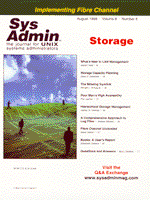
syslog
Although we discuss storage concerns frequently in our feature articles, it has been 18 months since the topic was the theme for an issue. While it is mere coincidence that this time lapse matches the theoretical doubling of capacity ("Grove's Law"), it is interesting to note the storage developments in that period. In February of 1998, 18-GB drives were about to hit the market, along with 4mm DDS-3, 8mm AIT, and Exabyte Mammoth tape drives. Presently, 36-GB disk drives are about to hit the market, and will be joined by updated versions of each of the popular tape formats, all with similarly doubled capacity. DLTtape, which has been the darling of the tape storage market for a number of years, is also advancing. Super DLTtape drives, with starting capacities of 100 GB, are expected to hit the market while this issue is at the printer. Eighteen months ago, I expressed concern that the doubling of tape capacity might not keep pace with drive capacities if TeraStor, the San Jose-based company working on near-field recording devices (with the help of plenty of powerful partners) was successful in bringing that technology to market. At that time, near-field recording promised a ten-fold increase in storage capacity, and was expected to do so on CD-quality media (as opposed to the more costly precision-machined substrata used in conventional disk drives). First-generation products using near-field recording have not yet hit the market, and will likely have more conservative capacities. If TeraStor and its partners are successful in taking the technology to production-level reliability, however, near field may yet be a powerful force in the future of data storage. Eighteen months ago, people were just starting to talk about Fibre Channel and Storage Area Networks (SANs). Now, however, SANs are the hottest topic in the storage arena. All major storage vendors have SAN offerings, or are busy putting the finishing touches on products to offer in that market segment. In addition to transfer rates in the 100MB/sec range, and campus-capable segment distances of up to 10 km, SANs have a lot to offer. But, as with any new technology, there are gaps in the offerings that you need to watch for. Cross-vendor compatibility is an issue that the industry is still working on. Most of the storage vendors are busily testing their products with various high-end servers, Fibre Channel switches, and interface cards. Parallel to that effort, the Storage Area Industry Association (SNIA) is working on standards in concert with several other industry groups. Once approved, such standards should minimize some of the risk with respect to compatibility. Early adopters of SAN technology are finding choices somewhat limited, and still fairly pricey. For specific applications, however, where the currently available products fit the requirements and have been well tested, the installations are real - not just the promise of technology that we saw in the past. What will be slower coming, however, is true cross-platform data sharing. For that to occur, one of two things must take place: either the broad adoption of a universal file system (don't hold your breath for that one), or a generally accepted standard for a broadly implemented translation protocol handled at the storage device level. Some progress has already been made in the latter area for use in Network Attached Storage (NAS) devices. The jury is still out on whether the storage industry will do any better than computer manufacturers and OS designers relative to agreeing on a single standard, however. Perhaps what we need is a fellow with a name like Spinner Storvalds to come along, and open up the issue.
Sincerely yours, |